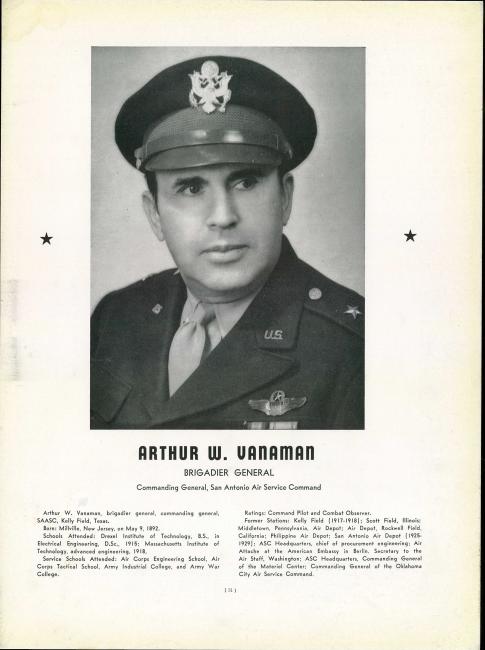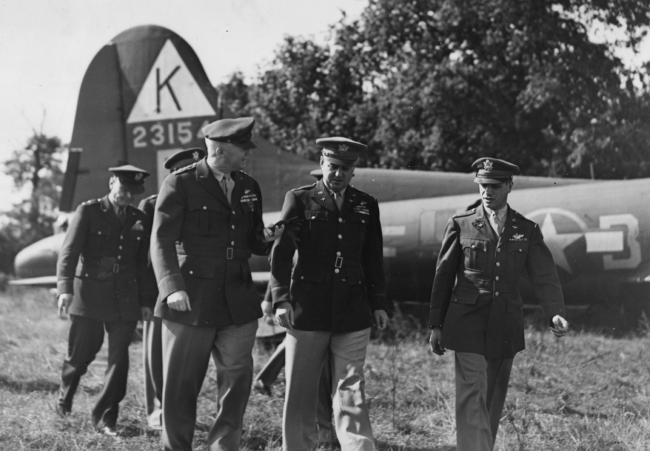Henry Harley Arnold
Military
IWM, Roger Freeman Collection
Object Number - FRE 9801 - General Henry H Arnold in London. Handwritten caption on reverse: 'HH Arnold in London, 1943.
Became "chief of the Army Air Forces on June 30, 1941, and that December he got a third star. When the War Department General Staff was organized in March 1942 Arnold became commanding general of Army Air Forces. Prior to and all during World War II, he directed air activities for the nation's global war against Germany and Japan. Under him the air arm grew from 22,000 officers and men with 3,900 planes to nearly 2,500,000 men and 75,000 aircraft. Early in 1943 Arnold made a 35,000-mile tour of North Africa, Middle East, India and China, and attended the Casablanca Conferences. In March 1943 he was promoted to four-star general. He suffered a heart attack in 1945 as the war drew to a close, attributed by his doctors to overwork. "
(Source: U.S. Air Force Biographical Dictionary by Flint O. DuPre, Colonel, U.S. Air Force Reserve)
Connections
See how this entry relates to other items in the archive by exploring the connections below.
People
- Military/Civilian/Mascot: Military
- Nationality: American
- Unit: 844th Engineer Aviation Battalion
- Highest Rank: Major
- Role/Job: Engineering Officer

- Military/Civilian/Mascot: Military
- Nationality: American
- Unit: 379th Bomb Group 524th Bomb Squadron
- Service Numbers: O-010506
- Highest Rank: Major General
- Role/Job: Pilot, Combat Observer, A-2 Berlin 1938-41, AWPD-42 Secretary of Air, Ultra-cleared, POW
Missions
- Date: 21 January 1943
- Official Description:
Events
| Event | Location | Date | Description |
|---|---|---|---|
|
Born |
Gladwyne, PA, USA | 25 June 1886 | |
|
Died |
Sonoma, California, USA | 15 January 1950 | |
|
Enlisted |
|||
|
Buried |
Plot: Section 34, Grave 44-A |
Revisions
Added Buried event per Find-a-grave Memorial ID 38.
SOURCE: https://www.findagrave.com/memorial/38/henry-harley-arnold
NARA files verified DSM w/2 oak leaf clusters, Legion of Merit and Air Medal. His DFC was earned prior to World War II.
Personal and biographical information taken from U.S. Air Force website at http://www.af.mil/AboutUs/Biographies/Display/tabid/225/Article/107811/…

![General Arnold addresses US Army 8th Air Force personnel inside a hangar. Image stamped on reverse: 'Barratt's Photo Press.' [stamp], 'Passed for publication 3 Sept 1943.' [stamp] and '282086.' [Censor no] A printed caption was previously attached to th reverse, however this has been removed. Associated News Story: 'American Air Forces GOC meets the "Boys" General Arnold Chief of the American Air Force, who arrived in this country yesterday, today paid a visit to a bomber station where he met members of t](https://assets.americanairmuseum.com/s3fs-public/styles/max_650x650/public/freeman/media-456620.jpg?itok=_aKp-mRQ)
![General Arnold addresses US Army 8th Air Force personnel inside a hangar. Image stamped on reverse: 'Barratt's Photo Press.' [stamp], 'Passed for publication 3 Sept 1943.' [stamp] and '282088.' [Censor no] Printed caption on reverse: 'American Air Forces GOC meets the "Boys" General Arnold Chief of the American Air Force, who arrived in this country yesterday, today paid a visit to a bomber station where he met members of the crews of some of the Fortresses just back from a raid. OPS: General Arnold Addre](https://assets.americanairmuseum.com/s3fs-public/styles/max_650x650/public/freeman/media-456646.jpg?itok=xlHa7HgU)





